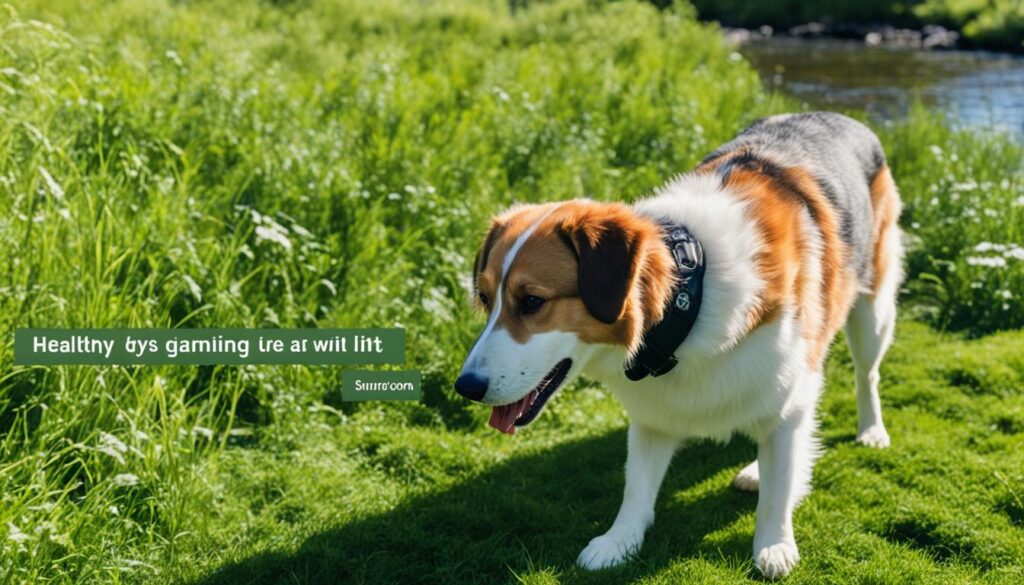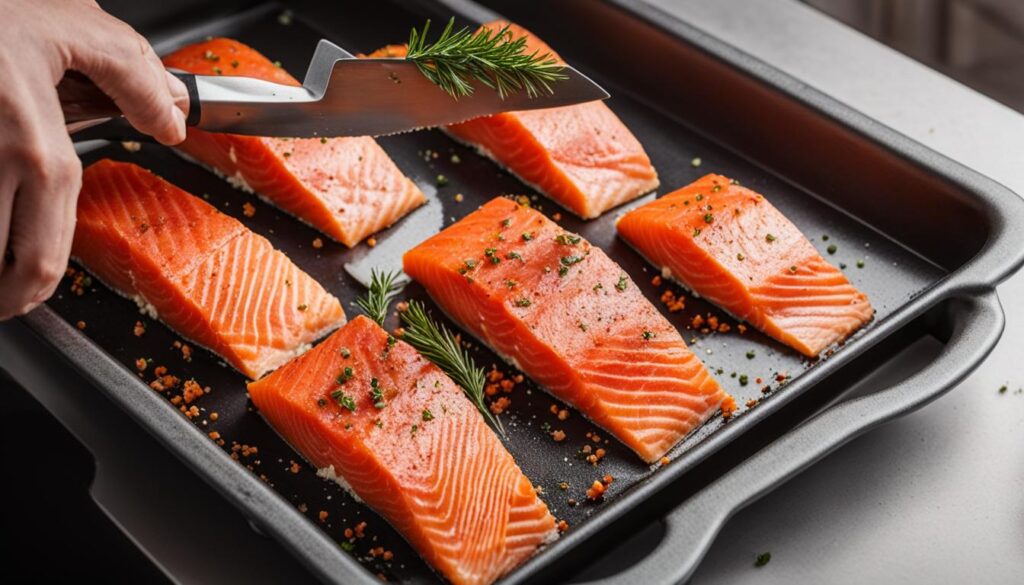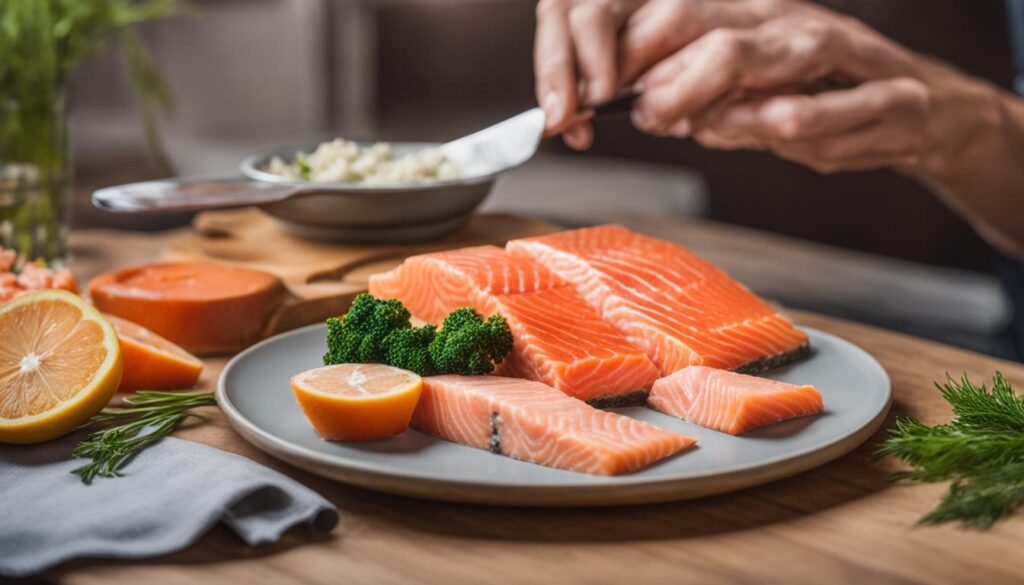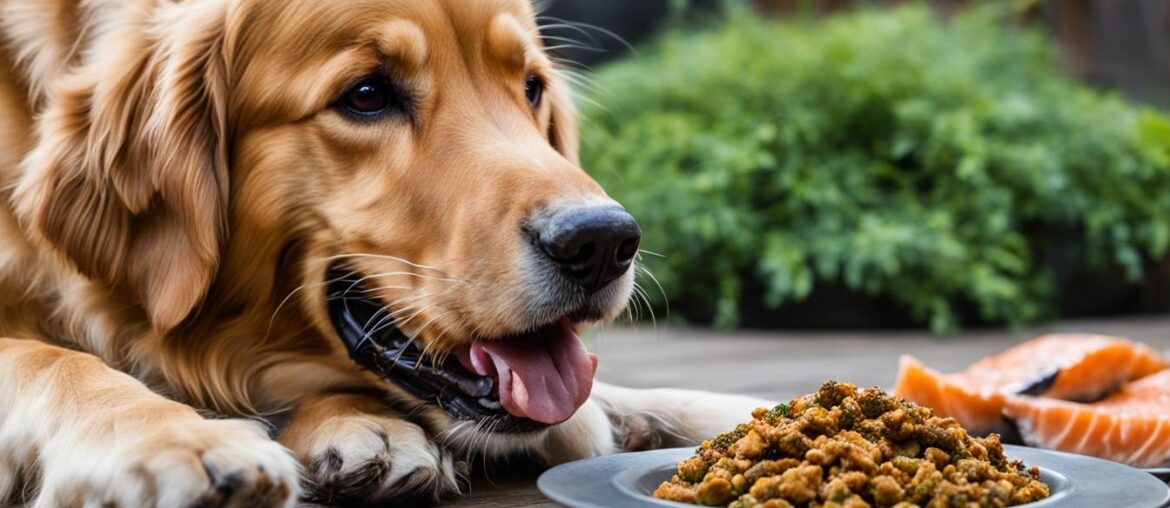Welcome to my article on whether or not salmon skin is good for dogs. Many pet owners wonder if it’s safe and beneficial to include this part of the fish in their furry friend’s diet. In this article, I will explore the topic of salmon skin for dogs, discussing its potential benefits and any risks or concerns. Let’s dive in!
Key Takeaways:
- Salmon skin is safe for dogs to eat when thoroughly cooked and without added seasoning or ingredients that may be toxic.
- It is rich in omega-3 fatty acids, which promote healthy skin and coat in dogs.
- However, moderation is important due to the high fat content in the skin.
- Feeding raw salmon to dogs should be avoided to prevent salmon poisoning disease.
- Consult with a veterinarian to determine the appropriate portion size of salmon for your dog based on their specific needs.
The Health Benefits of Salmon for Dogs

Cooked salmon can be a nutritious addition to a dog’s diet. It offers a range of health benefits, including:
- Omega-3 Fatty Acids: Salmon is rich in omega-3 fatty acids, such as EPA and DHA, which play a vital role in promoting healthy skin and coat in dogs. These essential fatty acids can help reduce dryness, itching, and inflammation, resulting in a shiny, lustrous coat.
- Protein: Salmon is a great source of high-quality protein, which is essential for various functions in a dog’s body. Protein supports muscle development, tissue repair, and overall growth. It also helps maintain a healthy immune system.
- Vitamins and Minerals: Salmon contains several important vitamins and minerals that contribute to a dog’s overall well-being. It is particularly rich in B vitamins, including niacin, thiamin, and vitamin B12, which promote proper energy metabolism and help maintain a healthy nervous system. Salmon also provides essential minerals like selenium, which acts as an antioxidant and supports immune function.
These health-boosting properties make salmon an excellent choice for dogs, especially those with skin issues, joint problems, or in need of a nutrient-dense diet.
Quote:
“Incorporating salmon into a dog’s diet can provide valuable omega-3 fatty acids, protein, and essential vitamins and minerals, offering a natural way to support their overall health and well-being.” – Dr. Emily Martinez, Veterinary Nutritionist
When feeding salmon to your dog, it’s important to remember that moderation is key. Too much fat from salmon can lead to weight gain and other health issues. Additionally, certain precautions should be taken when preparing salmon for dogs to ensure it is safe and free from any potential hazards.
| Health Benefits | Omega-3 Fatty Acids | Protein | Vitamins and Minerals |
|---|---|---|---|
| Role | Promote healthy skin and coat | Aid in muscle development | Support overall health and well-being |
| Food Sources | Salmon, fish oil | Salmon, meat, poultry | Fruits, vegetables, meats |
| Recommended Daily Intake | N/A | Varies based on weight and activity level | Varies based on age, weight, and specific nutrient needs |
Preparing Salmon for Dogs

When it comes to preparing salmon for dogs, there are a few important steps to follow to ensure the meal is safe and nutritious. Here are some key considerations:
1. Deboning the Salmon
Prior to cooking, it is crucial to remove any bones from the salmon. Bones can pose a choking hazard and could potentially harm your dog’s digestive system. Carefully inspect the salmon and use tweezers or clean, sharp kitchen utensils to remove any bones.
2. Cooking Methods
Salmon can be prepared for dogs using various cooking methods, including baking, boiling, grilling, and steaming. Choose a method that suits your dog’s preferences and your own cooking skills. Here’s a brief overview of each method:
- Baking: Place the deboned salmon on a lined baking tray and cook it in a preheated oven at about 350°F (175°C) for approximately 15-20 minutes, or until it flakes easily with a fork.
- Boiling: Submerge the salmon in a pot of boiling water, ensuring it is fully covered. Cook for about 6-8 minutes, or until it is cooked through and flaky.
- Grilling: Heat the grill to medium-high heat. Place the salmon on a greased grill grate and cook for about 4-6 minutes per side, or until it is opaque and flakes easily.
- Steaming: Use a steamer or a steamer insert in a pot to cook the salmon. Steam for approximately 10-12 minutes, or until it is fully cooked and easy to break apart.
Remember to avoid using seasonings, spices, or excessive oils when preparing the salmon for your dog. Dogs have sensitive stomachs and certain ingredients can be harmful to them.
3. Portion Control
When introducing salmon into your dog’s diet, it is important to practice portion control. While salmon is nutritious, it should be integrated gradually and in appropriate amounts. This helps prevent any digestive issues or an imbalance in their overall diet. Start with small portions and monitor your dog’s reaction before increasing the amount. Consult with your veterinarian for guidance on the ideal portion size based on your dog’s weight and specific dietary needs.
By following these steps and ensuring that the salmon is bone-free, properly cooked, and portioned, you can provide your dog with a healthy and enjoyable meal. Always prioritize your dog’s well-being and consult with a veterinarian if you have any concerns or questions.
Can Dogs Eat Raw Salmon?
Feeding dogs raw salmon poses significant risks and should be avoided. Raw salmon can contain parasites that cause salmon poisoning disease (SPD), which can be fatal if left untreated. It is crucial to prioritize the health and safety of your dog by thoroughly cooking salmon before feeding it to them.
Salmon poisoning disease (SPD) is a serious condition that affects dogs who consume raw salmon. The disease is caused by a parasite called Nanophyetus salmincola, which can be present in raw or undercooked salmon. When dogs ingest infected fish, the parasite releases a toxin that can lead to severe illness and even death if not treated promptly.
Thoroughly cooking salmon is the most effective way to eliminate the risks associated with feeding raw fish to dogs. Cooking salmon at a temperature of 145°F (63°C) or higher ensures that any potential parasites or bacteria are destroyed, making it safe for consumption by your canine companion.
By cooking salmon, you not only eliminate the risk of SPD but also provide your dog with a nutritious meal. Cooked salmon is a valuable source of omega-3 fatty acids, protein, and essential vitamins and minerals that promote overall health and well-being in dogs.
Remember to remove any bones from cooked salmon before feeding it to your dog. Small bones can pose a choking hazard or lead to intestinal blockages, causing serious harm to your pet. Ensuring that the salmon is boneless and properly cooked keeps your dog safe while enjoying the benefits of this nutritious fish.
In summary, raw salmon poses risks to dogs, including the potential transmission of parasites and the development of salmon poisoning disease. Thoroughly cooking salmon eliminates these risks, allowing you to provide your dog with a safe and nutritious meal. Prioritizing the health and well-being of your dog is crucial, and proper food preparation is an essential part of responsible pet ownership.
| Risks of Feeding Raw Salmon to Dogs | Salmon Poisoning Disease in Dogs |
|---|---|
|
|
Feeding Salmon Skin to Dogs

Salmon skin can be a nutritious addition to a dog’s diet when fed in moderation. Not only does it provide a tasty treat, but it also offers several health benefits for your furry companion. The nutritional value of salmon skin for dogs lies in its high content of omega-3 fatty acids, which play a crucial role in maintaining a healthy skin and coat (1).
Omega-3 fatty acids are essential for dogs as they promote skin hydration, reduce itching and inflammation, and improve overall coat quality. The omega-3 fatty acids found in salmon skin are particularly beneficial due to their higher concentration compared to other parts of the fish. Incorporating salmon skin into your dog’s diet can help address dry skin issues, allergies, and strengthen their coat, making it shiny and lustrous.
However, it is important to exercise caution when feeding salmon skin to dogs. Consuming too much salmon skin can lead to an excessive intake of fat, which can be harmful to their health. High-fat diets can increase the risk of pancreatitis, a condition that causes inflammation of the pancreas and can lead to serious complications (2). To prevent any potential risks, it is crucial to feed salmon skin in small amounts and alongside a well-balanced diet.
| Benefits of Feeding Salmon Skin to Dogs | Risks of Feeding Too Much Salmon Skin to Dogs |
|---|---|
|
|
When introducing salmon skin into your dog’s diet, it is recommended to start with small portions and observe their reaction. Keep an eye out for any signs of digestive upset such as vomiting or diarrhea. If your dog tolerates the salmon skin well, you can gradually increase the portion size while still maintaining moderation.
In summary, feeding salmon skin to dogs can be a healthy and flavorful addition to their diet. It provides valuable omega-3 fatty acids that support their skin, coat, and overall well-being. However, it is important to exercise portion control and monitor your dog’s fat intake to avoid any potential health risks. As always, consult with your veterinarian before making any significant changes to your dog’s diet.
How Much Salmon Can Dogs Eat?

The amount of salmon that dogs can safely consume depends on their weight. As a general guide, small portions of cooked, boneless salmon can be given to dogs on a weekly basis. It is important to consider portion control to ensure that your dog receives the appropriate amount of salmon for their size.
- Extra-Small Dogs: For dogs weighing up to 10 pounds, a portion size of 1-2 ounces of cooked, boneless salmon is recommended.
- Small Dogs: Dogs weighing between 10 and 20 pounds can be given 2-4 ounces of cooked, boneless salmon.
- Medium Dogs: Dogs weighing between 20 and 50 pounds can be given 4-6 ounces of cooked, boneless salmon.
- Large Dogs: Dogs weighing between 50 and 100 pounds can be given 6-8 ounces of cooked, boneless salmon.
- Extra-Large Dogs: For dogs weighing over 100 pounds, a portion size of 8 ounces of cooked, boneless salmon is recommended.
It is important to note that these portion sizes are general guidelines. Dogs with specific dietary needs or health conditions may require smaller or larger portions of salmon. Consulting with a veterinarian is always recommended to determine the appropriate portion size for your dog based on their specific needs.
Recommended Portion Sizes of Salmon for Dogs Based on Weight
| Weight Range (in pounds) | Portion Size (in ounces) |
|---|---|
| Up to 10 | 1-2 |
| 10-20 | 2-4 |
| 20-50 | 4-6 |
| 50-100 | 6-8 |
| Over 100 | 8 |
Note: The portion sizes listed above are meant to serve as a general guideline. Individual dogs may have specific dietary needs or health conditions that require adjustments to the portion sizes. Consulting with a veterinarian is crucial to ensure your dog’s nutritional requirements are met.
Risks and Concerns of Feeding Salmon to Dogs

Feeding salmon to dogs can come with certain risks and concerns that pet owners should be aware of. It is important to understand the potential health issues that may arise from including salmon in a dog’s diet. These concerns revolve around the risks of feeding raw or undercooked salmon, the presence of small bones in the fish, and the potential harm from seasonings and ingredients found in human preparations of salmon.
Risks of Feeding Raw or Undercooked Salmon to Dogs
Raw or undercooked salmon can potentially expose dogs to parasites and bacteria that may cause digestive problems or even salmon poisoning disease (SPD). SPD can be a serious condition that requires prompt veterinary care to prevent further complications or fatalities. It is crucial to thoroughly cook salmon before offering it to your furry companion to eliminate any potential health risks.
Concerns About Small Bones in Salmon
Salmon often contains small bones that can pose a choking hazard for dogs or even lead to intestinal blockages. These bones can splinter and cause injuries to a dog’s throat or digestive tract. It is imperative to remove all bones from the salmon before serving it to your pet. By doing so, you can ensure their safety and prevent any harmful incidents.
Potential Health Issues from Seasonings and Unsafe Ingredients
Some seasonings and ingredients commonly used in human preparations of salmon can be harmful to dogs. Garlic, onions, salt, and certain spices are among the ingredients that should be avoided, as they can cause toxicity or digestive upset in dogs. It is crucial to cook salmon plain and without any added seasonings, oils, or unsafe ingredients to protect your pet’s health.
Risks and Concerns Summary
In summary, there are various risks and concerns associated with feeding salmon to dogs. Raw or undercooked salmon can expose dogs to parasitic and bacterial infections, small bones in salmon can pose choking hazards or lead to intestinal blockages, and certain seasonings or ingredients used in human preparations of salmon can be harmful to dogs. To ensure the safety and well-being of your furry friend, it is crucial to cook salmon thoroughly, remove all bones, and avoid seasoning or using any unsafe ingredients.
| Risks and Concerns | Preventive Measures |
|---|---|
| Raw or undercooked salmon | Thoroughly cook salmon before feeding it to dogs |
| Small bones in salmon | Remove all bones from the fish before serving |
| Seasonings and unsafe ingredients | Cook salmon plain without added seasonings or unsafe ingredients |
Other Beneficial Forms of Salmon for Dogs

In addition to fresh cooked salmon, there are other alternative forms of salmon that can benefit dogs. Canned salmon is a convenient option that can be safely incorporated into their diet. It is important to choose plain canned salmon without added salt or harmful preservatives. Before serving, make sure to drain any excess liquids and remove bones to prevent choking hazards. Canned salmon can provide dogs with essential nutrients and omega-3 fatty acids, promoting a healthy skin, coat, and overall well-being.
Another way to incorporate salmon into a dog’s diet is through specialized dog food recipes. Many high-quality dog food brands offer recipes that include salmon as a main ingredient. These formulas provide a balanced and convenient option for ensuring dogs receive the nutritional benefits of salmon in a complete and well-rounded meal. When selecting a dog food with salmon, it is important to choose reputable brands that prioritize quality ingredients and adhere to rigorous safety standards.
Comparison Table: Fresh Cooked Salmon vs. Canned Salmon vs. Salmon in Dog Food
| Factors | Fresh Cooked Salmon | Canned Salmon | Salmon in Dog Food |
|---|---|---|---|
| Taste and Texture | Delicious and moist | Tender and moist | Varies depending on the brand and recipe |
| Convenience | Requires preparation and cooking time | Ready-to-serve | Ready-to-serve |
| Nutritional Value | High in omega-3 fatty acids, protein, vitamins, and minerals | Contains omega-3 fatty acids, protein, vitamins, and minerals, but may have higher sodium levels | Varies depending on the brand and recipe, formulated to meet specific nutritional needs |
| Portion Control | Flexible; can be adjusted based on the dog’s size and dietary requirements | Pre-portioned cans; may require dividing into smaller servings | Varies depending on the dog food brand and recommended feeding guidelines |
| Cost | Can be more expensive, especially if using high-quality salmon | Affordable | Varies depending on the brand and recipe |
As seen in the comparison table, each form of salmon has its own advantages and considerations. Fresh cooked salmon provides the flexibility of adjusting portion sizes and offers a delicious taste and texture. Canned salmon is convenient and ready-to-serve, making it a hassle-free option. Salmon in dog food provides a balanced and specifically formulated meal. Ultimately, the choice of which form of salmon to feed your dog depends on their individual needs, preferences, and dietary requirements. Consult with your veterinarian for personalized recommendations.
Wrapping Up
In conclusion, salmon can be a healthy addition to a dog’s diet when prepared and served properly. Cooked salmon is a great source of important nutrients that can benefit dogs in various ways.
One of the key benefits of salmon is its high content of omega-3 fatty acids. These essential fatty acids support healthy skin and coat, reduce inflammation, and promote joint health. Additionally, salmon is rich in protein, which is vital for muscle development and overall growth.
Salmon also contains valuable vitamins and minerals that contribute to a dog’s overall well-being. B vitamins found in salmon play a crucial role in energy metabolism, while minerals like selenium support antioxidant activity and cellular function.
However, it is essential to note that salmon should always be cooked thoroughly before feeding it to your dog. Raw or undercooked salmon can pose significant health risks to dogs, including the potential for parasitic infections and salmon poisoning disease. Moreover, portion control is crucial to prevent digestive issues and weight gain. Always consult with a veterinarian before introducing salmon or any other significant dietary changes to your dog’s meal plan, as your dog’s specific health needs should be considered.
FAQ
Is salmon skin good for dogs?
Salmon skin is safe for dogs to eat when thoroughly cooked and without any added seasoning or ingredients that may be toxic. It is rich in omega-3 fatty acids, which can promote healthy skin and coat in dogs. However, moderation is key, as too much fat in the skin can be harmful.
What are the health benefits of salmon for dogs?
Cooked salmon is a nutritious addition to a dog’s diet. It is rich in omega-3 fatty acids, which promote healthy skin and coat, improve mobility in dogs with joint issues, and supports overall well-being. Salmon is also a good source of protein and contains important vitamins and minerals.
How should I prepare salmon for dogs?
When preparing salmon for dogs, remove any bones that can pose a choking hazard. Salmon should be fully cooked using methods like baking, boiling, grilling, or steaming. Avoid using seasonings or excessive oils that can be harmful to dogs. Practice portion control and integrate salmon gradually into your dog’s diet.
Can dogs eat raw salmon?
Feeding dogs raw salmon is not recommended, as it can contain parasites that cause salmon poisoning disease (SPD), which can be fatal if left untreated. Thoroughly cook salmon to eliminate any potential risks and ensure your dog’s safety.
Can I feed salmon skin to my dog?
Salmon skin is safe for dogs to eat in moderation. It is higher in omega-3 fatty acids compared to the rest of the fish, making it a beneficial addition to a dog’s diet. However, feed it in small amounts and avoid excess fat intake.
How much salmon can dogs eat?
The amount of salmon dogs can safely consume depends on their weight. As a general guide, small portions of cooked, boneless salmon can be given on a weekly basis. Consult with your veterinarian to determine the appropriate portion size for your dog.
What are the risks and concerns of feeding salmon to dogs?
Feeding raw or undercooked salmon to dogs can transmit parasites and bacteria, leading to digestive problems and salmon poisoning disease. Small bones in salmon can pose a choking hazard or risk of intestinal blockage. Additionally, certain seasonings and ingredients used in human preparations of salmon can be harmful to dogs.
Are there other beneficial forms of salmon for dogs?
Besides fresh cooked salmon, canned salmon can be a safe option, as long as it is plain and free from added salt or harmful preservatives. Some dog food recipes also include salmon as a main ingredient, providing a convenient and balanced option for incorporating salmon into a dog’s diet.






